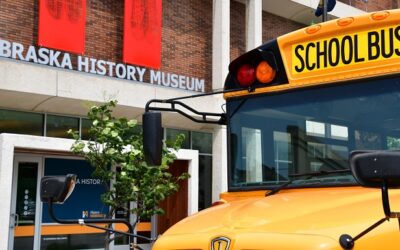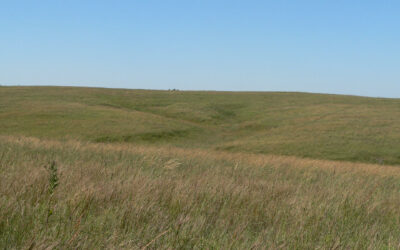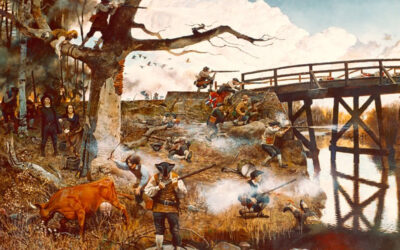HISTORY NEBRASKA MANUSCRIPT FINDING AID
RG1431.AM: Val Kuska/Chicago, Burlington & Quincy Railroad
Papers, records: ca. 1884-1964
Nebraska: Agricultural Development Agent for Chicago, Burlington & Quincy Railroad
Size: 109 cu.ft. + microfilm & oversize
HISTORICAL NOTE
By the middle of the 19th Century, conditions were right for the start of major efforts to settle and develop the interior of the United States. As the old modes of transportation became increasingly inadequate, a new one was developing to replace them, the railroad. Chicago was an area of major development of the new railroad system. Small lines like the Aurora Branch were springing up to meet the needs of growing commercial centers, and within a period of a few years these small lines had proliferated, connected track, merged with other short lines, or been absorbed by larger lines. Exemplifying this growth in 1864 were two rail lines, the Peoria and Burlington Railroad Company, and the Chicago, Burlington & Quincy Railroad Company. The C.B.&Q. was backed by a group of Boston investors, who also financed the growth and development of other short lines in areas farther west, and would absorb them as the developing main line came to meet already existing tract. Major among these other developments were the Burlington Hannibal & St. Joseph Railroad Company, organized at Burlington, Iowa, and the Hannibal & St. Joseph Railroad in Missouri. In 1869, C.B.&Q. controlled lines crossed the Missouri River at Plattsmouth, Nebraska, and continued westward.
Congress was aware of the need for railroad development and aided them by extending large grants of public lands to the various lines. These lands were to be sold by the railroads and the proceeds were to finance the extension of the lines across country. The C.B.&Q. received three of these grants: one in Iowa, one in Missouri, and one in Nebraska. Thus they were forced to enter a field as highly competitive as those of winning favorable right-of-way and obtaining goods and passengers for hauling. They had to out-bid bigger and longer established railroads like the Union Pacific for settlers to come west and buy the lands in their particular grants, for they had to have the lands settled in order to generate the commerce necessary to the survival of the railroad. To get the land populated the Burlington put on a massive advertising campaign, offering easy terms and relatively low prices to prospective settlers in the English-speaking countries as well as Germany, the Scandinavian countries, Bohemia and elsewhere.
The advertising of the Burlington route reflected the essentially local character of the railroad. By the end of the 1880s the railroad, with its subsidiary lines, had reached the limit of their expansion to the west. Major facilities extended to western Nebraska, with connection to Colorado, Wyoming, Montana, South Dakota, Oklahoma and Texas. The C.B.&Q. was interested in the agricultural development of these areas, and to that end embarked in their earliest advertising efforts to inform and educate their settlers. The Burlington performed great public service for years by printing hundreds of thousands of pamphlets emphasizing the agricultural possibilities of states and counties. Their educational materials cover such topics as: rural economics; soil and crop rotation; climatological data; reports on area business; irrigation and conservation; land reclamation; educational institutions; crops and livestock raising and improvement, and other subjects. Among the most notable of their educational and informational campaigns were the special trains sent around the country, mainly during the 1920s. These trains were organized to take exhibits directly to farmers, ranchers and rural businesses. The trains offered intensive informational opportunities in livestock, poultry and crops.
BIOGRAPHICAL NOTE
The name of Val Kuska is deeply involved in the promotional work of the Burlington railroad. Born Valentine Kuska in Fillmore County, Nebraska, in 1887, he was educated at Milligan High School. He graduated in 1910 from the University of Nebraska School of Agriculture, after which he spent some time managing ranches and farms in Nebraska. After serving in World War I, he spent several years as a colonizer in Colorado for a Denver land company.
In 1922 he joined the C.B.&Q. as a colonizing agent and as an agricultural development agent for the first two decades. Kuska participated extensively in the Burlington’s many educational and promotional programs. He prepared promotional materials to precede the campaigns, and usually accompanied the special trains as they traveled. His early training enabled him to bring to his work a wealth of experience in agricultural problems and solutions. He was early convinced of the incapacity of dry farming techniques to suit future agricultural needs, and he worked vigorously for irrigation and land reclamation projects. Kuska has been widely recognized for the important part he played in obtaining local, state and federal support for projects such as the Central Nebraska Public Power and Irrigation District. Mr. Kuska retired from the railroad in 1957. He passed away in Lincoln, Nebraska, on May 21, 1972.
SCOPE AND CONTENT NOTE
This collection consists of two Subgroups of material. Subgroup 1 is made up of materials from the Agricultural Development Office of the C.B.&Q. and relates to improvement of farming methods, crops and livestock, to irrigation and to promotion for the encouragement of immigration. The files have been left organized according to Val Kuska’s original organizational scheme. Additional materials received at a later date did not have Kuska’s numbering system associated with them. These materials were added to the end of the subgroup (boxes 78-87).
Subgroup 2 consists of materials obtained from the Burlington railroad storage sheds, also through the efforts of Mr. Kuska. This group is mostly composed of statistical material, and is further divided into twelve Series.
Series 1 contains what are called “22” Reports. These reports, dating from 1917-1959, constitute an excellent source for the study of rail traffic in the 20th Century. A “22” report is a comparative report of freight forwarded and received at a given station over a stated period of time. Under the general headings of carloads forwarded and received, it lists specific articles of freight such as: agricultural implements and vehicles; butter, eggs and poultry; coal, hard and soft; feed and grain; iron and steel; livestock; vegetable oil; and sugar. With this information it indicates whether these figures, given for a two-year period, constitute an increase or decrease, and how much. Also given are numbers and kind of carload freight received and forwarded from and to the reporting station, their origin or destination, as well as the consignor and consignee. These reports are available on microfilm only.
Series 2 of Subgroup 2 consists of station reports–periodic reports from Lincoln, Denver, Omaha, and Sioux City covering 1907-1945. These reports are detailed summaries of shipments to and from the given stations for each month of the reporting year. Information given includes: origin and destination, and type of commodity in total carload receipts and deliveries; line charges; summaries of total deliveries and receipts of given commodities, etc. Series 3 of Subgroup 2 consists of consolidated “22” reports. These are merely compilations of some of the “22” reports for the given years, and are not complete within the reporting years.
Series 4 of Subgroup 2 consists of interchange reports. These are as described in the supplement, giving various kinds of information concerning interchange of rail shipments with other lines. Series 5 of Subgroup 2 consists of commodity statistics. These reports are printed summaries of commodities in terms of ton carried and freight revenue over given railroads for single or comparative years.
Series 6 of s Subgroup 2 consists of “37” reports, which indicate carloads per month of shipment of grain, livestock, fuel products, etc. over the various divisions or to particular stations on the Burlington lines. Series 7-11 consist of annual reports to stockholders, miscellaneous reports, employee records, special correspondence and miscellaneous materials. It should be remembered that in none of the series is the material included complete within the reporting period. However, the material as a whole exists in sufficient volume to give basis for comparison. Series 12 contains timetables of the Burlington & Missouri River Railroad and Chicago, Burlington & Quincy Railway. The inclusive dates of the timetables are 1884-1986.
This collection was donated to the Nebraska State Historical Society through the efforts of Mr. Val Kuska, and with the cooperation of the Chicago, Burlington & Quincy Railroad Company.
Funding to better organize and describe this collection was graciously provided by The Andrew W. Mellon Foundation administered through the Council on Library and Information Resources.
Click here for a PDF Inventory of the Kuska collection.
TMM/cj 09-12-2013





